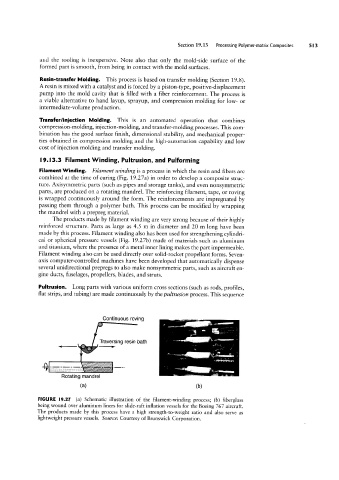Page 533 - 04. Subyek Engineering Materials - Manufacturing, Engineering and Technology SI 6th Edition - Serope Kalpakjian, Stephen Schmid (2009)
P. 533
Section 19.13 Processing Polymer matrix Composites
and the tooling is inexpensive. Note also that only the mold-side surface of the
formed part is smooth, from being in contact with the mold surfaces.
Resin-transfer Molding. This process is based on transfer molding (Section 19.8).
A resin is mixed with a catalyst and is forced by a piston-type, positive-displacement
pump into the mold cavity that is filled with a fiber reinforcement. The process is
a viable alternative to hand layup, sprayup, and compression molding for low- or
intermediate-volume production.
Transfer/injection Molding. This is an automated operation that combines
compression-molding, injection-molding, and transfer-molding processes. This com-
bination has the good surface finish, dimensional stability, and mechanical proper-
ties obtained in compression molding and the high-automation capability and low
cost of injection molding and transfer molding.
l9.l3.3 Filament Winding, Pultrusion, and Pulforming
Filament Winding. Filament winding is a process in which the resin and fibers are
combined at the time of curing (Fig. 19.27a) in order to develop a composite struc-
ture. Axisymmetric parts (such as pipes and storage tanks), and even nonsymmetric
parts, are produced on a rotating mandrel. The reinforcing filament, tape, or roving
is Wrapped continuously around the form. The reinforcements are impregnated by
passing them through a polymer bath. This process can be modified by wrapping
the mandrel with a prepreg material.
The products made by filament winding are very strong because of their highly
reinforced structure. Parts as large as 4.5 m in diameter and Z() m long have been
made by this process. Filament Winding also has been used for strengthening cylindri-
cal or spherical pressure vessels (Fig. 19.27b) made of materials such as aluminum
and titanium, Where the presence of a metal inner lining makes the part impermeable.
Filament winding also can be used directly over solid-rocket propellant forms. Seven-
axis computer-controlled machines have been developed that automatically dispense
several unidirectional prepregs to also make nonsymmetric parts, such as aircraft en-
gine ducts, fuselages, propellers, blades, and struts.
Pultrusion. Long parts with various uniform cross sections (such as rods, profiles,
flat strips, and tubing) are made continuously by the pultrusion process. This sequence
f.
Continuous roving
<-i i>
Traversing resin bath
Rotating mandrel
(a) (b)
FIGURE l9.27 (a) Schematic illustration of the filament-Winding process; (b) fiberglass
being Wound over aluminum liners for slide-raft inflation vessels for the Boeing 767 aircraft.
The products made by this process have a high strength-to-Weight ratio and also serve as
lightweight pressure vessels. Source: Courtesy of Brunswick Corporation.

